- NLI Research Institute >
- The Prospects for Strategic Outsourcing in Japan
The Prospects for Strategic Outsourcing in Japan
Osamu Kubotani
Font size
- S
- M
- L
1. Strategic Outsourcing
Companies who use external management resources and functions generally have considered the following factors.
- difficulty in performing certain operations inhouse
- cost reduction
- introducing expertise from the outside
- focusing management resources on the core business area
The first factor involves operations such as facility management and shipping, where the content or characteristics pose many problems in terms of personnel and equipment for the company, and must be delegated to an outside firm specializing in that operation. While the second factor of cost reduction is related to the first, it represents the clearest objective of outsourcing, where providers can do something at less cost that the company can, and decision making is conducted smoothly. Thus for first two factors, outsourcing is done out of tactical considerations that precede any strategic consideration. It is when the remaining two factors come into play that outsourcing becomes strategic.
(1) Effective Use of External Expertise
The concept behind effectively using external expertise to achieve strategic goals includes but goes beyond the objective of cost reduction. Indeed, this strategy may incur short-term cost increases in order to introduce expertise. There are numerous cases of outsourcing in areas such as information technology (IT), research & development, and consulting. As a manager who has successfully and vigorously applied outsourcing puts it: "Considering the speed of information technology and dizzying pace of change in the business environment, it's smarter to use the most advanced outside services rather than try to do things ourselves."
(2) Focusing Management Resources on Core Business Areas
Outsourcing of supplemental or peripheral operations in order to focus management resources on core business areas is the most strategic and extreme application of outsourcing. A straightforward form, as expressed by a Keyence executive, is "to leave only the creative work inhouse, and outsource all the routine work." The Japanese expression that captures this approach is to "buy mochi from the rice cake maker" rather than making it oneself, and specialize all management resources on what the company does best. The logic of outsourcing is one of division of labor among companies − what is peripheral work to the outsourcing company is a core business to the vendor.
In this strategy, the key question is not what to outsource, but rather what to retain as a core business. Thus companies need to carefully examine what core business they are competitive in, which is not easy to do. To simplify and define what is meant by core business, it is "a business that competitors cannot easily catch up in." Typical examples of companies who use strategic outsourcing to focus on core business areas are Keyence, Misumi, and Kankyo. These companies concentrate solely on research & development in their core business areas, are fabless (do not operate their own fabrication plant), and even outsource their marketing and sales operations.
Thus outsourcing becomes strategic in nature only when used to purchase expertise or focus on core business areas. Used effectively, such outsourcing greatly helps a company add more value. The growth of strategic applications also encourages the specialization of providers, thereby enhancing the quality of the outsourcing market.
According to a survey conducted by the Outsourcing Institute in the U.S., the most common strategic objectives of companies who use outsourcing are to improve business focus, access world class capabilities, accelerate the benefits of reengineering, and diversify risk. These objectives indicate the advanced level of outsourcing activity in the U.S.
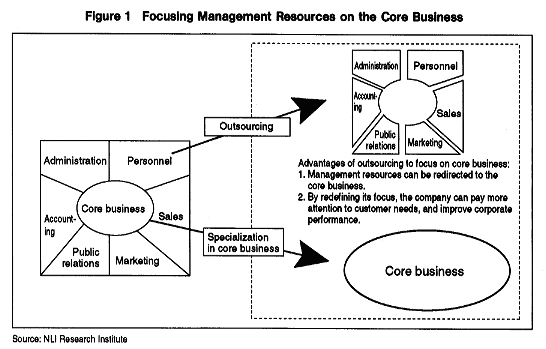
2. Obstacles to Strategic Application
(1) Japanese Management Style
Japanese companies, particularly large companies, have a persistent tendency to perform all functions either within the company or group. Moreover, since companies value their organizations and people under the belief that administrative and personnel functions are pivotal to the company, there is great resistance to destroying this time honored principle by introducing outsourcing. Also, the drastic organizational shakeup and transfer of employees entailed by strategic outsourcing threatens lifetime employment and other employment practices peculiar to Japan. These tendencies are visible by the fact that despite the legacy of bloated managements from the bubble era, the ratio of sales administration costs and ratio of white collar employees remain stubbornly high, and are even rising (Figure 2).
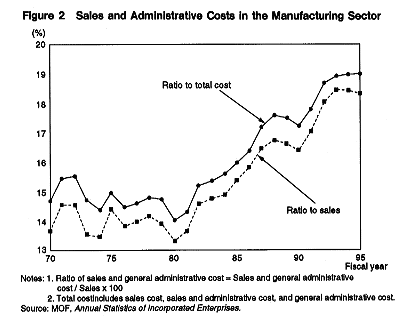
(2) Lack of Specialized Vendors
Vendors have increased sharply in recent years. Over 80 companies offering unique services to businesses have become listed on the OTC market since 1990. However, the overall situation remains inadequate, since with the exception of information systems and some other areas, very few companies possess a high level of specialization. This immaturity of vendors in the outsourcing market impedes the growth of demand from users.
Compared to the U.S., the scarcity of specialized vendors in Japan can be attributed not only to the immaturity of the outsourcing market itself, but also to the absence of the following factors which have fostered outsourcing in the U.S.:
- Profit-oriented corporate management
- Active investment in information technology
- Large number of new companies
In addition, after gaining expertise at large companies over many years, professionals in the U.S. often leave to establish their own company and use their experience and expertise. On the other hand, since large Japanese companies tend to produce generalists rather than specialists, few employees can leave to for a venture based on a marketable expertise.
(1) Large Companies
As explained earlier, when a large company tries to outsource in a new area, it meets great internal resistance. Moreover, the scarcity of qualified vendors in terms of expertise and size further complicates the problem. Thus for large companies, the strategic value of outsourcing will grow in their traditional outsourcing areas such as logistics (physical distribution) and facility management. In fact, the quality of vendors in these areas has also improved remarkably.
1.Physical Distribution
Physical distribution is an area that companies have had extensive outsourcing experience. While conventional outsourcing has mostly consisted of simple shipping and storage operations, recently more companies are outsourcing their entire physical distribution function (Table 1).
This is occurring against the backdrop of advances in information technology, which enables specialized vendors equipped with order handling systems, operational management systems, and computer controlled warehouses to use their information networks and enhance their capabilities. In addition, specialist vendors are getting better than the inhouse capabilities of large companies at handling smaller lots of many products more frequently and quickly.
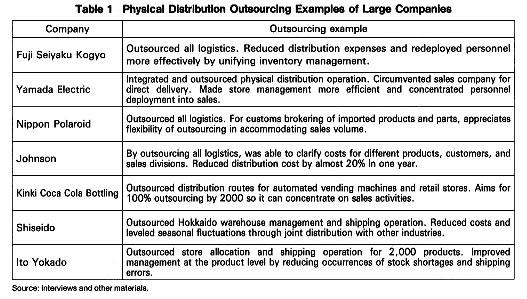
2.Facility Management
Almost all the facility maintenance and management work of companies has been outsourced to building maintenance, property management, and security companies. In the past, this area consisted mainly of cleaning, equipment maintenance, and security services. However, in the 1980s, a comprehensive approach to facility management that grew substantially in the west is now challenging the traditional approach in Japan. The new approach goes beyond the objective of simply maintaining the status quo, and aims to provide comprehensive and company-wide support by linking together corporate management efficiency with facility management. For example, one service examines the optimal placement of facilities to enhance a company's organizational and sales strategies. Judging from developments in the west, this area will develop in stages toward higher value added content by encompassing not only space management, but also peripheral areas such as environmental control, real estate acquisition and management, consulting, and project management (Figure 3).
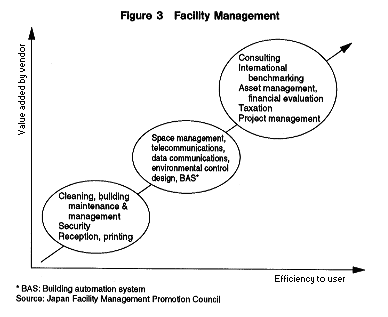
(2) Small, Medium and Second-Tier Companies
On the other hand, due to underdeveloped administrative systems and difficulties in hiring specialists for specific duties, second tier and smaller companies are expected to make considerable advances in strategic outsourcing for administration, accounting, personnel, and welfare functions. These companies, by fully using the expertise and networks of vendors, will be able to obtain a higher quality of services from the outside than they could provide on their own.
Vendors in this area are growing rapidly. Unlike the traditional outsourcing areas of logistics and facility management, many new businesses are emerging. The strong outsourcing demand fueling this growth comes mainly from second tier and smaller companies.
For example, the outside resources available to companies seeking personnel services used to consist of employment agencies and training and development services. But recently, a number of vendors have emerged that integrate all personnel matters including personnel systems, employee information systems, and hiring. More companies are outsourcing administrative functions such as compiling monthly account settlements and purchasing, as well as employee welfare functions such as health management, company cafeterias, and management of company housing and employee welfare facilities.
New entrants into these areas include large companies as well as venture businesses, many of which are growing rapidly. Large employment agencies are moving beyond simply providing temporary workers and providing integrated solutions including the calculation of payrolls and operation of company day care centers. Ventures with unique names such as "administration," "accounting," and "employee welfare" are marketing their proprietary systems and expertise to serve the administrative needs of smaller companies.
4. Further Development of the Outsourcing Market
(1) Ventures, New Businesses, and Outsourcing
There is a group of companies in the Silicon Valley area called contract manufacturers whose business is to support startups in a variety of ways. Entrepreneurs and budding ventures may have unique technologies and ideas, but their growth is hindered by a lack of funding and human resources. Used effectively, these outside management resources can help ventures start up and grow. Outsourcing has already become a necessary part of business strategy for venture businesses in the U.S.
Compared to the introduction of outsourcing at ordinary companies that are already in business, ventures have are more apt to pursue a strategy that effectively uses outside resources from the beginning. Many vendors in Silicon Valley are available for outsourcing functions ranging from R&D to manufacturing. These vendors perform a vital role in nurturing the growth of ventures. In Japan as well, the growth of vendors should be promoted by outsourcing demand from a promising reserve of new businesses, whether they be started by established businesses or as ventures.
(2) Public Services and Outsourcing
Outsourcing of public services is a common practice in countries such as the U.S., U.K., Australia, and New Zealand. An often cited example is the outsourcing by the state government of Southern Australia of all state government data processing work over the next nine years to EDS (Electronic Data Systems). Recently, even basic public services in the U.S. such as police, prisons, and schools are being outsourced to the private sector.
While Japan is seeing some movement toward the outsourcing of public sector services such as elderly welfare, school lunches, and garbage collection, the pace is much slower than in other countries. However, from a different perspective, Japan's public service sector represents a potentially huge demand for outsourcing.
Considering the diversity of services conducted by the government and the enormous administrative work involved, the public service sector will have to actively use outsourcing in the future to improve the efficiency of services and reduce costs. In fact, one survey has already found that outsourcing public services to the private sector has significantly slashed costs ((Table 2). Since private sector participation brings the principle of competition comes into play, the quality and availability of services (speedier service and availability on weekends and nights, etc.) can be expected to improve with outsourcing.
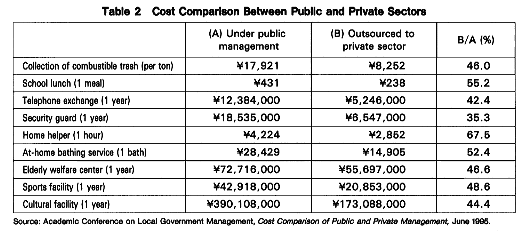
As explained above, Japan's outsourcing market faces many obstacles toward strategic application. However, we expect strategic outsourcing to expand among large companies in the traditional outsourcing areas of logistics and facility management, and among smaller companies in new areas such as administrative functions, employee welfare, and so forth. Moreover, two other areas − venture business support and public service outsourcing − are expected to hold the key to the rapid growth of the market in the future.
In particular, the fiscal deficit will force the government to look more closely at the issue of outsourcing public services. Once public services start to be actively outsourced, it will raise the level of vendors. This is the most direct way to establishing strategic outsourcing.
Osamu Kubotani
Research field
レポート紹介
-
研究領域
-
経済
-
金融・為替
-
資産運用・資産形成
-
年金
-
社会保障制度
-
保険
-
不動産
-
経営・ビジネス
-
暮らし
-
ジェロントロジー(高齢社会総合研究)
-
医療・介護・健康・ヘルスケア
-
政策提言
-
-
注目テーマ・キーワード
-
統計・指標・重要イベント
-
媒体
- アクセスランキング

















